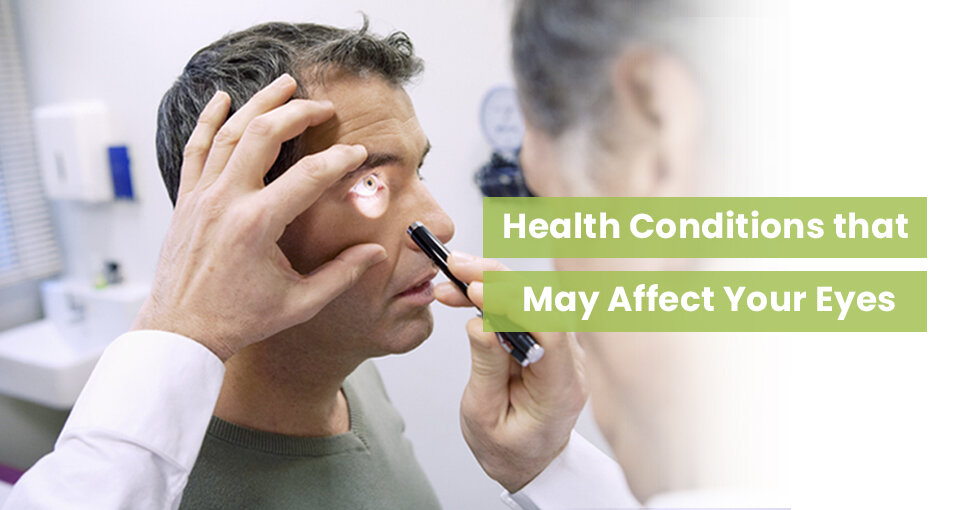8 Health Conditions That Can Affect Your Eyes

The quality of your vision and the health of your eyes play an important part in your overall well-being. In addition to ocular disorders that you may have heard of, such as glaucoma or cataracts, there are a number of health conditions that you may not realize can affect eyesight.
Autoimmune Diseases
There are many different types of autoimmune diseases, which are medical conditions that cause the immune system to attack healthy cells. Some can cause eye symptoms that range from mild irritation and itching to more serious pain or vision changes. As many as one-third of patients with Lupus, a common autoimmune condition, experience ocular complications, such as dry eyes, scleritis, and uveitis.

Diabetes
Diabetes is a disease that is primarily characterized by an inability to properly process blood sugar, but it can also have serious effects on vision and eye health. People with Type 1, Type 2, or gestational diabetes are at risk of developing diabetic retinopathy which causes blood vessels in the retina to leak and can cause vision loss if left untreated.

Herpes
Herpes simplex virus is a common and easily spread disease that is known for causing cold sores. Many people do not know that herpes can spread to the eyes, where it can cause irritation, light sensitivity, pain, and viral conjunctivitis. In fact, approximately 40,000 people suffer from vision impairment or blindness each year due to corneal inflammation as a result of a herpes infection.

Hypertension (High Blood Pressure)
Patients with high blood pressure are often advised to change their lifestyle habits, but they may not know that hypertension can affect their eyesight if left untreated. Patients with chronic high blood pressure can experience retinopathy (blood vessel damage), choroidopathy (ocular fluid buildup), or optic neuropathy (a blockage of blood flow to the eyes).

Measles
Measles is a viral infection that was virtually eliminated in the United States, but has recently had a resurgence. While measles is still rare in the U.S., children can be especially susceptible to serious health complications. According to the American Academy of Ophthalmology, measles can cause conjunctivitis, keratitis, corneal scarring, retinopathy, and blindness.

Rheumatoid Arthritis
Rheumatoid arthritis, also known as RA, is a condition that causes painful inflammation and autoimmune symptoms, and can also affect ocular health. The Arthritis Foundation outlines several ways RA can affect eyesight, including scleritis, which causes painful thinning of the cornea. Patients with RA may also have a higher risk of developing cataracts.

Sickle Cell Disease
Also called sickle cell anemia, or SCD, this genetic blood cell disorder can cause vision issues. Of particular concern are proliferative sickle retinopathy and central retinal artery occlusion, two conditions in which the blood flow to the retina is restricted or blocked. If left untreated, vision issues caused by SCD can lead to retinal detachment or vision loss.

Shingles
Anyone who has had chickenpox is at risk of developing shingles, which is a condition caused by the reactivation of the same virus. While shingles is typically characterized by a painful rash, the Centers for Disease Control and Prevention (CDC) also warns that it can cause vision loss or blindness if the virus spreads to the eye.

How Can I Maintain Eye Health and Protect My Vision?
Many ocular health issues do not cause symptoms right away, but early detection is critical in preventing vision loss. Your eyesight is important and you can protect it by scheduling regular comprehensive eye exams with an experienced eye doctor. The American Optometric Association recommends that adults have their eyes examined at least every 2 years, and once a year if you are over 65 or have any risk factors for eye diseases. A dilated eye exam will allow your optometrist or ophthalmologist to analyze your eye health and check for a number of conditions.

 Sources
Sources
1 Shoughy SS, Tabbara KF. Ocular findings in systemic lupus erythematosus. Saudi J Ophthalmol. 2016 Apr-Jun; 30(2): 117–121.
2 National Eye Institute. Facts About Diabetic Eye Disease. https://nei.nih.gov/health/diabetic/retinopathy Accessed September 10, 2019.
3 Watson S, Cabrera-Aguas M, Khoo P. Common eye infections. Aust Prescr. 2018 Jun; 41(3): 67–72.
4 American Heart Association. The eyes have it for high blood pressure clues. https://www.heart.org/en/news/2018/12/13/the-eyes-have-it-for-high-blood-pressure-clues Accessed September 10, 2019
5 American Academy of Ophthalmology. Six Ways Measles Can Affect the Eyes. https://www.aao.org/eye-health/tips-prevention/six-ways-measles-can-affect-eyes-2 Accessed September 10, 2019.
6 Arthritis Foundation. Dunkin MA, Wait M. 6 Ways Arthritis Can Affect Your Eyes. https://www.arthritis.org/living-with-arthritis/comorbidities/eye-conditions/eye-arthritis.php Accessed September 10, 2019.
7 Ventocilla, M. Ophthalmologic Manifestations of Sickle Cell Disease. Medscape. https://emedicine.medscape.com/article/1918423-overview#showall. Accessed September 10, 2019.
8 Centers for Disease Control and Prevention. Shingles (Herpes Zoster). https://www.cdc.gov/shingles/about/complications.html Accessed July 5, 2024.
9 American Optometric Association. Recommended Eye Examination Frequency for Pediatric Patients and Adults. https://www.aoa.org/patients-and-public/caring-for-your-vision/comprehensive-eye-and-vision-examination/recommended-examination-frequency-for-pediatric-patients-and-adults Accessed September 10, 2019.




